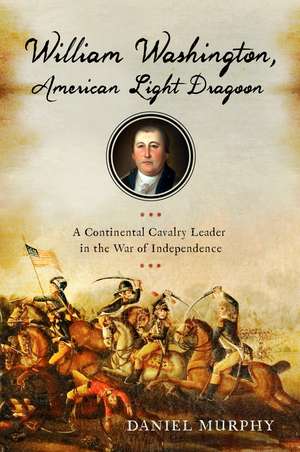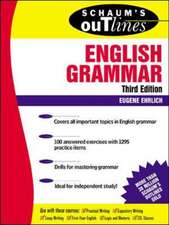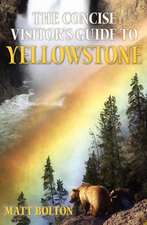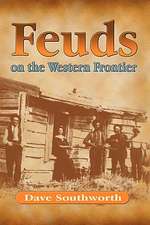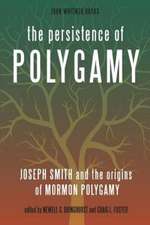William Washington, American Light Dragoon: A Continental Cavalry Leader in the War of Independence
Autor Daniel Murphyen Limba Engleză Paperback – 17 apr 2020
A Relative of George Washington, the Life and Service of One of America's Great Cavalry Leaders
William Washington began the war as a captain of Virginia Militia, was commissioned a junior officer in the Continental Infantry, and slowly rose to field command in the Continental Light Dragoons where he built one of the hardest hitting cavalry regiments to serve in the war. His chief adversary Lord Cornwallis commented, “There could be no more formidable antagonist in a charge, at the head of his cavalry, than Colonel William Washington.” Despite his connection to the commander-in-chief, he suffered his fair share of setbacks, and his relationships varied with not only his legendary cousin George, but many well-known figures of the Revolution including, Henry Lee, Casimir Pulaski, Nathanael Greene, and Daniel Morgan. Relying largely on firsthand accounts and period letters, in William Washington: American Light Dragoon: A Continental Cavalry Leader in the War of Independence, author and avid equestrian Daniel Murphy blends these primary sources with his own working knowledge of period drill, tactics, and terrain to deliver a more complete view of William Washington’s actions throughout the conflict. This perspective traces the often overlooked role of cavalry in the American Revolution and sheds new light on many pivotal battles in of the war, including Trenton, Cowpens, Guilford Courthouse, Hobkirk’s Hill, and William Washington’s final action at Eutaw Springs.
William Washington began the war as a captain of Virginia Militia, was commissioned a junior officer in the Continental Infantry, and slowly rose to field command in the Continental Light Dragoons where he built one of the hardest hitting cavalry regiments to serve in the war. His chief adversary Lord Cornwallis commented, “There could be no more formidable antagonist in a charge, at the head of his cavalry, than Colonel William Washington.” Despite his connection to the commander-in-chief, he suffered his fair share of setbacks, and his relationships varied with not only his legendary cousin George, but many well-known figures of the Revolution including, Henry Lee, Casimir Pulaski, Nathanael Greene, and Daniel Morgan. Relying largely on firsthand accounts and period letters, in William Washington: American Light Dragoon: A Continental Cavalry Leader in the War of Independence, author and avid equestrian Daniel Murphy blends these primary sources with his own working knowledge of period drill, tactics, and terrain to deliver a more complete view of William Washington’s actions throughout the conflict. This perspective traces the often overlooked role of cavalry in the American Revolution and sheds new light on many pivotal battles in of the war, including Trenton, Cowpens, Guilford Courthouse, Hobkirk’s Hill, and William Washington’s final action at Eutaw Springs.
Preț: 108.27 lei
Nou
Puncte Express: 162
Preț estimativ în valută:
20.72€ • 22.15$ • 17.27£
20.72€ • 22.15$ • 17.27£
Carte disponibilă
Livrare economică 27 martie-10 aprilie
Livrare express 12-18 martie pentru 26.43 lei
Preluare comenzi: 021 569.72.76
Specificații
ISBN-13: 9781594163432
ISBN-10: 159416343X
Pagini: 240
Ilustrații: 25
Dimensiuni: 152 x 229 x 20 mm
Greutate: 0.4 kg
Ediția:1
Editura: Westholme Publishing, U.S.
Colecția Westholme Publishing
ISBN-10: 159416343X
Pagini: 240
Ilustrații: 25
Dimensiuni: 152 x 229 x 20 mm
Greutate: 0.4 kg
Ediția:1
Editura: Westholme Publishing, U.S.
Colecția Westholme Publishing
Recenzii
“William Washington, perhaps the best American cavalry officer of the War of Independence, has yet to receive the recognition he merits. In this comprehensively researched volume, Daniel Murphy provides a detailed and engaging account of Washington’s life and battlefield exploits that restores this gifted commander to his rightful place among the outstanding military leaders of the Revolution.”—Jim Piecuch, author of “Light Horse Harry Lee” in the War for Independence
“Murphy has combined all currently known written sources on William Washington with his vast experience as a mounted reenactor to produce a study of Nathanael Greene’s cavalryman. This is a very good read and sheds lights on a man who should be much better known.” —Lawrence E. Babits, author of A Devil of a Whipping: The Battle of Cowpens
“Murphy has combined all currently known written sources on William Washington with his vast experience as a mounted reenactor to produce a study of Nathanael Greene’s cavalryman. This is a very good read and sheds lights on a man who should be much better known.” —Lawrence E. Babits, author of A Devil of a Whipping: The Battle of Cowpens
Notă biografică
DANIEL MURPHY is a graduate of Stephen F. Austin State University with a B.F.A. in Cinematography and Art History. He has worked in the film industry for twenty-five years with a specialty in lighting and stage rigging. He is a classically trained fencer, avid equestrian, and eighteenth-century living historian. He has authored numerous articles on mounted combat and eighteenth- century warfare and has served as a cavalry coordinator and historical advisor on films for the National Park Service. He lives in Edneyville, North Carolina.
Descriere
A Relative of George Washington, the Life and Service of One of America's Great Cavalry Leaders
William Washington began the war as a captain of Virginia Militia, was commissioned a junior officer in the Continental Infantry, and slowly rose to field command in the Continental Light Dragoons where he built one of the hardest hitting cavalry regiments to serve in the war. His chief adversary Lord Cornwallis commented, “There could be no more formidable antagonist in a charge, at the head of his cavalry, than Colonel William Washington.” Despite his connection to the commander-in-chief, he suffered his fair share of setbacks, and his relationships varied with not only his legendary cousin George, but many well-known figures of the Revolution including, Henry Lee, Casimir Pulaski, Nathanael Greene, and Daniel Morgan. Relying largely on firsthand accounts and period letters, in William Washington: American Light Dragoon: A Continental Cavalry Leader in the War of Independence, author and avid equestrian Daniel Murphy blends these primary sources with his own working knowledge of period drill, tactics, and terrain to deliver a more complete view of William Washington’s actions throughout the conflict. This perspective traces the often overlooked role of cavalry in the American Revolution and sheds new light on many pivotal battles in of the war, including Trenton, Cowpens, Guilford Courthouse, Hobkirk’s Hill, and William Washington’s final action at Eutaw Springs.
William Washington began the war as a captain of Virginia Militia, was commissioned a junior officer in the Continental Infantry, and slowly rose to field command in the Continental Light Dragoons where he built one of the hardest hitting cavalry regiments to serve in the war. His chief adversary Lord Cornwallis commented, “There could be no more formidable antagonist in a charge, at the head of his cavalry, than Colonel William Washington.” Despite his connection to the commander-in-chief, he suffered his fair share of setbacks, and his relationships varied with not only his legendary cousin George, but many well-known figures of the Revolution including, Henry Lee, Casimir Pulaski, Nathanael Greene, and Daniel Morgan. Relying largely on firsthand accounts and period letters, in William Washington: American Light Dragoon: A Continental Cavalry Leader in the War of Independence, author and avid equestrian Daniel Murphy blends these primary sources with his own working knowledge of period drill, tactics, and terrain to deliver a more complete view of William Washington’s actions throughout the conflict. This perspective traces the often overlooked role of cavalry in the American Revolution and sheds new light on many pivotal battles in of the war, including Trenton, Cowpens, Guilford Courthouse, Hobkirk’s Hill, and William Washington’s final action at Eutaw Springs.
